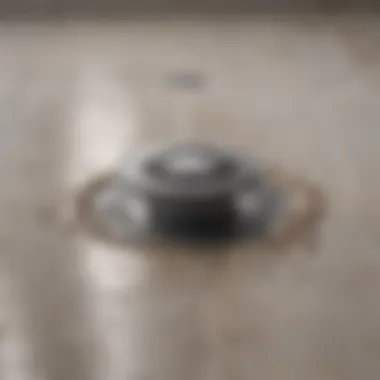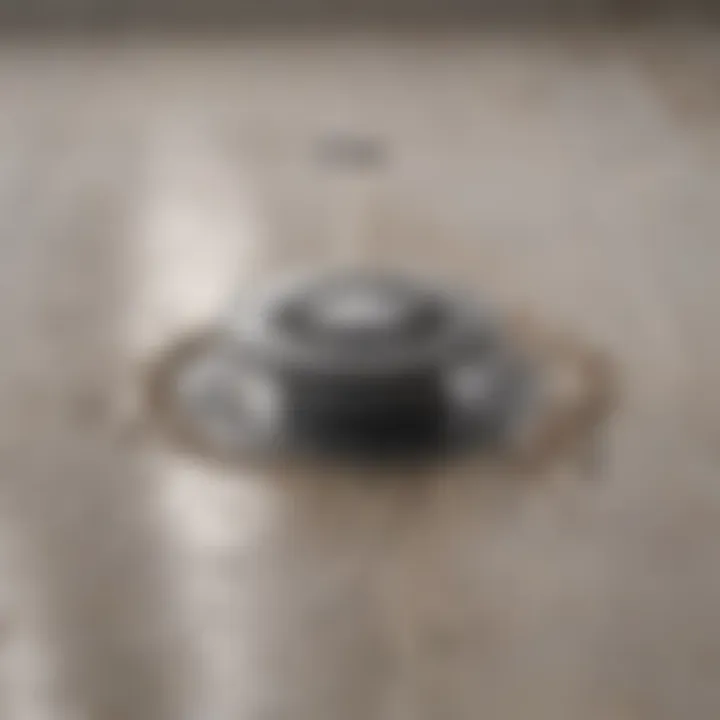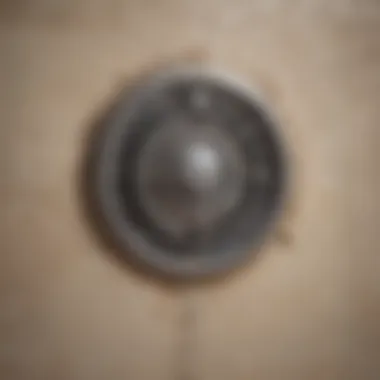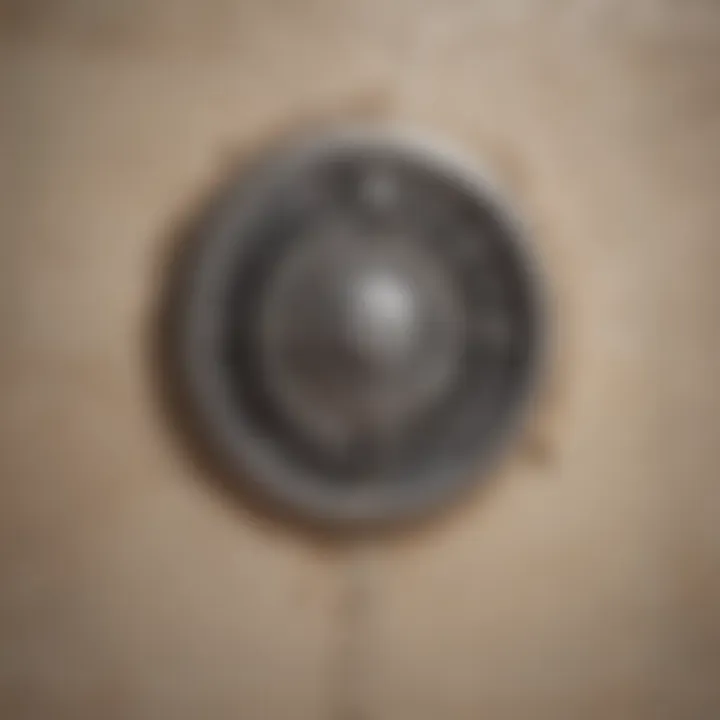Comprehensive Guide to Fixing a Blocked Shower Drain


Intro
A blocked shower drain is a common household problem that can affect anyone. It can disrupt your daily routine and result in unpleasant odors. Understanding how to address this issue is essential for maintaining your home’s plumbing and ensuring a pleasant shower experience. This guide provides a detailed exploration of methods to fix a blocked shower drain, focusing on do-it-yourself solutions, professional assistance, and preventative measures.
The intention is to equip homeowners and design aficionados with practical knowledge. A clear comprehension of how your plumbing operates empowers you to tackle minor issues before they escalate. This article also highlights aesthetic considerations, crucial in creating a harmonious living space that functions efficiently.
Exquisite Architectural Designs
Unique Home Features
A unique aspect of many homes is their plumbing designs, which can directly influence the functionality of a shower drain. Older homes may have outdated plumbing that is more prone to blockages due to material deterioration and design inefficiencies. In contrast, newer homes often feature advanced systems that minimize these concerns.
The layout of your plumbing system can determine the likelihood of clogs. For example, a shower with shorter drainage paths often experiences fewer issues. Additionally, investing in high-quality materials can prevent problems related to wear and corrosion.
Historical Significance
The evolution of plumbing systems tells a fascinating story about human ingenuity. Ancient civilizations made significant strides in plumbing, employing intricate systems to manage water flow. This history influences modern designs and encourages homeowners to appreciate the engineering behind their own residential systems. Understanding this history might deepen one's respect for the pipes hidden behind walls and beneath floors.
Addressing Blocked Shower Drains
Blocked drains can stem from various causes. Common culprits include hair buildup, soap residue, and foreign objects. By understanding these causes, homeowners can better approach problem-solving.
DIY Solutions
Addressing a blocked drain starts with simple, do-it-yourself techniques.
- Boiling Water: Pouring boiling water down the drain can help break down soap and grease.
- Baking Soda and Vinegar: This natural solution can effectively loosen debris. The process involves pouring a half-cup of baking soda followed by one cup of vinegar. After a few minutes, flush with hot water.
- Plumbing Snake: If the blockage is more significant, a plumbing snake allows you to reach deeper clogs.
"Regular maintenance and awareness are key to preventing shower drain clogs and minimizing plumbing issues."
When to Seek Professional Help
If the drain remains blocked after your attempts, it may be time to contact a professional plumber. Persistent clogs can indicate more significant problems that require expert knowledge and advanced tools to resolve, such as an issue with the main sewer line.
Preventative Measures
Prevention is always better than cure. Simple habits can significantly reduce the risk of future blockages:
- Use drain covers to catch hair and debris from entering the pipe.
- Regularly clean the drain using baking soda and vinegar.
- Periodically inspect plumbing for any signs of wear or damage.
Culmination
A blocked shower drain is an inconvenience that can easily be managed with the right knowledge and tools. Understanding the causes, applying DIY solutions, and knowing when to consult a professional forms the basis of effective home maintenance. By being proactive, homeowners can ensure a healthy and functional drainage system that complements the aesthetic and functional aspects of their home.
Understanding Blocked Shower Drains
Understanding blocked shower drains is crucial for homeowners and enthusiasts who wish to maintain proper functionality in their plumbing systems. The significance of recognizing this issue extends beyond mere convenience. A blocked drain can lead to various problems, including unpleasant odors, potential water damage, and health hazards. Addressing blockages promptly helps prevent these complications and extends the lifespan of the drainage system.
Identifying the nature of the blockage is essential as it influences the approach for remediation. Common causes range from hair accumulation to the build-up of soap scum and mineral deposits. By being aware of these contributors, one can take proactive steps to limit their impact and mitigate future issues. This section lays the foundation for deeper investigation into these causes and potential solutions.
Common Causes of Blockages
Hair Accumulation
Hair accumulation is often the primary culprit of blocked shower drains. As hair sheds during showers, it can become entangled with soap residue and other debris, forming a dense clump that obstructs water flow. This unique characteristic of hair is significant because it is prevalent in most households, making it a common and easily identifiable reason for blocked drains.
Enabling regular cleaning can aid in reducing hair-related blockages. However, neglecting the removal of hair can lead to more severe issues over time, which may necessitate professional intervention.
Soap Scum Build-Up
Soap scum build-up occurs when soap interacts with minerals in water, creating a residue that coats drain pipes. This characteristic can cause blockages as the scum clings to debris and other materials, forming larger obstructions. The oily nature of soap scum allows it to trap hair and grime, exacerbating the blockage.
This build-up often goes unnoticed until serious drainage issues arise, illustrating the importance of routine maintenance. Neglecting soap scum can result in costly renovations due to persistent water flow complications.
Mineral Deposits
Mineral deposits result from hard water usage, where minerals like calcium and magnesium accumulate in pipes over time. Their hardness contributes to the blockage problem, as they silently limit water flow and create a perfect medium for further blockage development.
The presence of these deposits serves as a warning sign for homeowners. Using water softeners or regular maintenance can minimize mineral accumulation, promoting optimal drainage performance and longevity of plumbing systems.
Symptoms of a Blocked Drain
Slow Drainage
Slow drainage is a primary indicator of a potential blockage in the shower drain. When water drains slowly, it's not only an inconvenience but also a symptom signaling underlying problems needing attention. Identifying slow drainage early allows one to take proactive measures, potentially stopping issues from escalating.
This characteristic is beneficial for homeowners as it serves as an early warning. Recognizing slow drainage can motivate individuals to engage in preventive actions, such as routine cleaning and maintenance.
Unpleasant Odors
Unpleasant odors emanating from drains are a clear sign of a potential blockage. These smells usually signal the accumulation of trapped debris or stagnant water within the drain, creating a breeding ground for bacteria.
This unique feature underscores the need for addressing drainage issues promptly. Keeping the drain clean not only alleviates unpleasant smells but also contributes positively to overall home hygiene.
Water Backing Up
Water backing up into the shower or other areas indicates severe blockage. This issue often points to a significant obstruction within the drainage system, and it’s an urgent concern that needs prompt action.
Observing water backing up is critical for homeowners because it reflects a system in distress. Understanding this signal can lead to timely interventions, potentially avoiding extensive and costly repairs due to prolonged neglect.
In summary, knowing how to identify and understand the causes and symptoms of blocked shower drains is essential. This knowledge empowers homeowners to take timely action, ensuring the longevity and functionality of their plumbing systems.
Initial Assessment and Diagnosis
The initial assessment and diagnosis of a blocked shower drain are critical steps in addressing the issue effectively. This phase serves to identify the root causes of the blockage and determine the severity, which in turn guides the subsequent actions required for remediation. By conducting a thorough inspection, homeowners can differentiate between minor clogs that may be addressed with simple DIY solutions and severe blockages that necessitate professional intervention. The benefits of proper assessment also include preventing further damage to plumbing, saving time, and minimizing unnecessary expenses.


Inspecting the Drain
Visual Checks
Conducting visual checks is an essential first step when assessing a blocked shower drain. This method involves examining the drain area for any obvious signs of blockage, such as standing water, debris accumulation, or discoloration around the drain. The key characteristic of visual checks lies in their simplicity and accessibility, allowing homeowners to undertake this assessment without special skills or tools. Moreover, it provides immediate insights into potential issues, enabling early intervention.
One unique feature of visual checks is the ability to spot external factors that may contribute to the blockage, such as damaged drain covers or loose tiles obstructing the drain flow. The advantages of this approach include the quick identification of minor issues that can be resolved without further complexity. However, a limitation is that not all blockages are visible externally, meaning hidden clogs deeper within the plumbing system may go unnoticed.
Utilizing Drain Cleaning Tools
Utilizing drain cleaning tools further enhances the assessment process. Tools such as a plumber's snake or a plumbing auger can penetrate deeper into the drainage systems, providing a clearer picture of the nature and location of the blockage. This characteristic makes drain cleaning tools a beneficial choice for anyone tackling a blocked shower drain. They allow for a more thorough examination than visual inspections alone.
A unique feature of these tools is their ability to remove obstructions that are not visible from the surface. This means that even if the initial visual checks do not reveal any problems, the use of a snake or auger can uncover deeper issues. This proactive measure helps in avoiding future plumbing complications significantly. However, they do require some level of familiarity or caution to prevent damage to the pipes, representing a potential disadvantage for inexperienced users.
Identifying Blockage Severity
Minor Blockages
Understanding minor blockages is key to effective drainage management. These blockages typically manifest as slow drainage but do not lead to any immediate overflow or unpleasant odors. This characteristic highlights the importance of early detection in preventing escalation into severe issues. Since minor blockages can often be remedied through simple DIY solutions, they represent a beneficial aspect of maintaining plumbing systems.
The unique feature of minor blockages is that they can usually be resolved with household items like plungers or baking soda and vinegar, making them a popular choice for homeowners looking to save on repair costs. However, ignoring these signs can lead to more significant blockages that might require professional plumbing services, which poses a disadvantage if not acted upon promptly.
Severe Blockages
In contrast, severe blockages present a much more challenging situation. These often lead to water backing up into the shower, creating an unsightly and unhygienic environment. The key characteristic of severe blockages is their ability to cause widespread disruption, not just in the shower but potentially throughout the entire plumbing system. Their identification is crucial, as they require more than just simple remedies to manage effectively.
A unique feature of severe blockages is that they might also indicate deeper systemic issues within the plumbing infrastructure, such as tree roots intruding into pipelines or broken pipes. This aspect emphasizes the need for professional assessment, as DIY solutions may not suffice. The advantage of recognizing severe blockages early is that it allows homeowners to avoid expensive damage and repairs down the line. However, the disadvantage is the potential for considerable inconvenience and repair costs if left unresolved.
DIY Solutions for Blocked Shower Drains
Dealing with a blocked shower drain can be a frustrating experience. Opting for do-it-yourself methods not only saves on plumbing costs, but also empowers homeowners to manage household maintenance more effectively. DIY solutions often use readily available tools and materials, making them accessible to a wide group of individuals. Furthermore, these approaches can provide quick relief for minor blockages, ensuring timely and efficient drainage without the need for professional intervention. However, it is crucial to recognize that while DIY methods provide immediate resolution, their effectiveness can vary based on the severity of the blockage, and therefore should be applied thoughtfully.
Basic Tools and Materials Needed
Plunger
A plunger is a fundamental tool in any household. Plungers work on the principle of pressure, creating suction that can dislodge minor clogs. Their key characteristic is simplicity. Unlike other tools, plungers do not require extensive knowledge or experience to use effectively. They are often the first line of defense against blockages.
One unique feature of the plunger is its versatility; it can be utilized in various drains, including toilets and sinks. However, one should note that while plungers are generally cost-effective and easy to store, their effectiveness diminishes with severe clogs. People may find themselves needing other tools if initial attempts do not succeed.
Drain Snake
A drain snake, also known as a plumber's auger, is designed to reach further into the plumbing. Its main aspect is its ability to tackle more stubborn clogs that a plunger cannot resolve. The key characteristic of the drain snake is its long, flexible design, which allows it to maneuver through pipes and reach blockages that are deep within.
This tool is particularly beneficial for blockages caused by hair or soap deposits, which are often found further down the drain. Its unique feature is the metal coil that can grab or break apart the items causing the blockage. However, using a drain snake may require some practice to avoid damaging the pipes, making user caution essential.
Baking Soda and Vinegar
The combination of baking soda and vinegar presents a natural alternative to chemical drain cleaners. This method relies on a basic chemical reaction to help clear clogs. The key characteristic of this approach is its non-toxic nature, making it a safer option for households with children or pets.
The unique feature of baking soda and vinegar is their ability to break down certain materials without harsh chemicals. While they may be less effective against severe blockages, this technique can work well for minor buildups or general maintenance. One downside is that it may require several applications to achieve significant results, as it is not a one-size-fits-all solution.
Implementing DIY Methods
Using a Plunger
The act of using a plunger is straightforward. To implement this method, simply cover the drain with the plunger's rubber cup and ensure a seal. Firmly push down and pull back without breaking the seal. Repeating this process several times usually generates enough pressure to dislodge minor blockages. The key advantage of this method is its accessibility; plungers are available at most stores and are relatively inexpensive.
However, it is essential to remember that this method may fail for severe clogs, causing a need for alternative solutions.
Employing a Drain Snake
Using a drain snake involves inserting the flexible wire into the drain until reaching resistance, indicating the blockage. Once at the location of the clog, the user can turn the handle to break the blockage apart or pull it out. This method is especially effective for blockages deep in the pipes, often removing items that cause issues like hair or debris.
The challenge with a drain snake is the need for careful handling. Improper use can lead to pipe damage, so beginners should consult online tutorials or guides for proper techniques before attempting.
Baking Soda and Vinegar Technique
To use the baking soda and vinegar technique, one must start by pouring about half a cup of baking soda down the drain, followed by a cup of vinegar. Let the mixture sit for several minutes, allowing the reaction to occur. Afterward, flush the drain with hot water to help clear the remnants.
This method is advantageous due to its ease of access and eco-friendliness. However, multiple attempts may be necessary for tough blockages, as it is not as effective as mechanical methods. Regular application can help maintain drainage, but users should not rely on it for severe blockages.
When to Seek Professional Help
Recognizing when to call a plumber is crucial for home maintenance. Not all drainage issues are suited for DIY solutions. Understanding the signs and the severity of a blocked shower drain will save you time and potential costs by avoiding further damage. Sometimes, it is not just a matter of stubborn hair or soap scum. Structural problems or extensive blockages may lurk below the surface, necessitating professional intervention.
Signs You Need a Plumber
Recurring Issues
Recurring issues with your shower drain can be a major red flag. When water continues to back up even after attempts to clear it, the blockage might be deeper or more complex than it appears. This persistent problem indicates that there could be an underlying issue, such as damaged pipes or tree roots invading the drainage system.
The key characteristic of recurring issues is predictability. If you find yourself using DIY methods frequently, it is not sustainable. This point establishes why seeking professional help is often a beneficial choice. Professionals have the tools and expertise to address these recurring issues, ensuring a long-term resolution, unlike quick fixes that only provide temporary relief.
Multiple Drain Problems
Experiencing blockages in multiple drains signals a more significant plumbing problem. It suggests that there is not only an issue with a single shower drain but possibly a wider systemic issue affecting the plumbing in the home. The unique feature of multiple drain problems is their interconnectedness—when one drain is blocked, others may follow, leading to more complicated issues.
Addressing multiple drain problems requires a holistic approach to plumbing. It is crucial to seek professional help as they can analyze and diagnose interconnected systems, providing solutions that a homeowner may overlook. While it may seem convenient to troubleshoot individually, this can lead to costly repairs if the core problem is not addressed effectively.
Choosing a Qualified Professional
Choosing a qualified plumber is essential to ensure effective and safe repairs. You may encounter various professionals, but not every plumber is equipped to handle your specific issue. Understanding how to select the right individual can save you time and money.
Credentials and Licenses


One of the most significant aspects of choosing a plumber is verifying their credentials and licenses. Licensed plumbers have met specific training and testing requirements, ensuring that they are familiar with local codes and regulations. This characteristic reinforces why such credentials are essential in an article focused on solving plumbing issues.
A licensed professional brings expertise and reliability to the table. Conversely, hiring someone without a proper license could lead to unsatisfactory work, potential legal issues, and liability for further damage. Proper credentials provide peace of mind that the plumber understands the plumbing systems and can perform the necessary repairs in compliance with standards laid down.
Reviews and Referrals
Reviews and referrals play a vital role in selecting a qualified professional. They offer real-world insights into the proficiency and dependability of a plumber. The key characteristic of this approach is that it grounds your decision in actual experiences from previous customers.
By consulting reviews or asking for referrals from friends or family, you can gauge a plumber's quality of work, reliability, and customer service. While it is feasible to read reviews online, personal recommendations often carry more weight. The unique feature of relying on reviews is that it helps to create a more informed decision-making process. In this article, leveraging reviews and referrals minimizes the risk of poor decisions that could lead back to unresolved plumbing issues.
Preventative Measures for Drain Maintenance
Blocked shower drains can lead to various inconveniences and costly repairs. By understanding and implementing preventative measures, homeowners can save themselves from significant headaches. These measures are essential not only for immediate functionality but also for long-term health of plumbing systems.
Routine Cleaning Practices
Routine cleaning practices are vital in maintaining a healthy shower drain. Regular task help to avoid the accumulation of harmful elements that contribute to blockages.
Regular Hair Removal
Regular hair removal is a simple yet effective method to prevent shower drains from getting blocked. Hair tends to accumulate over time, creating a dense mass that restricts water flow. By regularly removing hair from the drain, individuals can significantly decrease the likelihood of a blockage.
The key characteristic of this practice is its simplicity. A few minutes after each shower can save hours of frustration later. Regular hair removal is a popular approach because it requires no special tools or significant investment, just a basic commitment to routine maintenance.
The unique feature of this approach is that it addresses the problem before it escalates. While it does require some regular effort, the advantages far outweigh the nuisance of potential blockages. However, it’s important to remember that it may not always capture all hair, especially if showering habits change.
Monthly Deep Cleaning
Monthly deep cleaning plays an essential role in drain maintenance. It goes beyond casual, everyday cleaning and dives deeper into the unseen issues within a drain. This practice targets soap scum, mineral deposits, and other substances that may accumulate and contribute to blockages.
The characteristic of monthly deep cleaning is its thoroughness. While it might take more time than regular cleaning, this practice can greatly benefit both the shower and the entire plumbing system. It also reduces the chances of dealing with a more complex blockage in the future.
A unique aspect of this approach is the use of various cleaning agents or techniques, such as vinegar and baking soda, which not only clean but can also deodorize the drain. Though it requires time and effort, the overall advantages include improved drainage efficiency and the prevention of larger issues, such as major clogs or backups.
Utilizing Drain Covers
Using drain covers is a simple yet effective solution for maintaining clear drains. These covers can physically block debris, hair, and other materials from entering the drain and causing blockages.
Types of Drain Covers
Types of drain covers vary in design and material. Some are made of metal, while others are constructed from plastic or rubber. Each serves the same basic purpose, which is to keep unwanted materials out of the drain.
The most notable feature of drain covers is their accessibility and installation ease. They are available in various shapes and sizes, making them suitable for a range of shower designs. This option is gaining popularity because it is a proactive approach, often requiring minimal effort to install.
One advantage is that many models are easy to clean and maintain. However, a disadvantage could be if they aren't properly secured, they may come loose, allowing debris to enter the drain.
Benefits of Using Drain Covers
The benefits of using drain covers extend beyond merely trapping debris. They also help in reducing odors caused by stagnant water or decomposing matter in the drain. Additionally, drain covers can act as filters, providing a first line of defense against larger blockages.
The distinguishing character of these benefits is the simplicity of installation and maintenance. They are cost-effective and help in preventing extensive plumbing issues in the long run. This practice is especially beneficial for households with children or pets, where hair accumulation can be higher.
Overall, while drain covers do require an upfront investment for purchase, their long-term benefits can outweigh costs in terms of reduced plumbing issues and maintenance needs.
"An ounce of prevention is worth a pound of cure. In plumbing, this adage rings especially true."
By integrating these practices into an ongoing maintenance routine, homeowners can effectively mitigate the risks of a blocked shower drain. Regular attention to cleaning and preventative measures will ensure that shower drains function optimally.
Understanding Plumbing Basics
In the realm of home maintenance, understanding plumbing basics is essential. This knowledge serves as the foundation for effectively addressing issues, particularly when dealing with problems like a blocked shower drain. A clear comprehension of how plumbing systems operate is crucial. It helps homeowners make informed decisions and saves time and money. Ignoring these fundamentals may lead to repeated problems or significant repair costs.
How Shower Drain Systems Work
Gravity and Drainage
Gravity plays a vital role in how shower drain systems function. Water naturally flows downward, relying on gravity for drainage. Each component of the drainage system must be properly aligned to facilitate this process. A drain that is sloped incorrectly can hinder water flow, leading to blockages and overflow.
Key characteristics of gravity drainage systems include their simplicity and efficiency. They do not rely on pumps, making them a cost-effective choice for many homeowners. The unique feature of gravity drainage systems lies in the way they utilize the natural force. However, one disadvantage is that, without proper slope, even a minor defect can cause significant drainage issues.
Ventilation Systems
Ventilation systems are equally important in maintaining proper drainage. They ensure that air can circulate freely within the plumbing system. This circulation helps prevent vacuum situations that could impede water flow. A well-ventilated system reduces the likelihood of gurgling noises and unpleasant odors that can arise from blockages.
The primary benefit of a good ventilation system is its ability to enhance drainage efficiency. It creates a balanced pressure that promotes the smooth movement of wastewater. One unique aspect is the incorporation of vents that allow gases to escape, preventing backpressure. However, improper installation of these systems can lead to further complications.
Importance of Proper Drain Slope
Drainage Efficiency
The slope of the drain is critical for drainage efficiency. Ideally, the slope should guide water downwards at an angle of at least 1/4 inch per foot. This ensures that water moves away promptly, reducing the risk of blockage. Drainage efficiency not only promotes flow but also minimizes stagnation, which can lead to foul odors and health risks.
A correctly angled drain allows water and debris to exit swiftly. This characteristic makes proper drainage slope a highly beneficial choice for preventing issues related to blockage. If the slope is incorrect, water may pool, and the risk of clogs increases significantly.
Common Slope Mistakes
Unfortunately, common slope mistakes can lead to various drainage problems. Homeowners often underestimate the importance of maintaining the correct angle. Some may even install drains in a flat position, causing major issues. Another mistake is failing to account for changes in plumbing layouts, such as turns or bends that could disrupt flow.
Recognizing these mistakes is crucial to ensuring proper drainage. They reveal a lack of understanding of how drainage works as a system. Addressing these errors can save homeowners from costly repairs or extensive blockages in the future. Therefore, attention to slope is not just beneficial; it is essential for a functional plumbing system.
Cost Considerations for Drain Repairs
Understanding cost considerations for drain repairs is crucial for homeowners seeking to maintain their plumbing systems without incurring unnecessary expenses. A blocked shower drain can escalate in severity and cost if not addressed promptly. Therefore, assessing potential expenses is vital to make informed decisions about DIY solutions or professional interventions.
Estimating DIY Repair Costs


Basic Tools Cost
Basic tools needed for DIY drain repairs include a plunger, a drain snake, or even a mix of baking soda and vinegar. The cost of these tools varies, but they are generally affordable. A plunger can cost around $10, while a simple drain snake may range from $15 to $30. The investment in tools often pays for itself over time as homeowners can address minor clogs without professional help. Moreover, the usability of these tools in multiple scenarios makes their cost justified, so it becomes a reasonable consideration for this guide's readers.
The key characteristic of investing in basic tools is accessibility. Homeowners who possess these implements can address minor issues promptly, leading to less stress and potential damage. However, a unique feature of DIY repair tools is their intermittent necessity; some may not be used frequently but can become essential when unexpected clogs occur.
Material Expenses
Material expenses involve items like drain cleaning solutions or organic cleaning mixes that assist in breaking down blockages. These materials are often more budget-friendly than professional services. Basic materials like baking soda and vinegar can be found at a local grocery store, costing less than $5 total, making them a practical option for routine maintenance.
The key characteristic of these materials is their availability. Homeowners can usually find them in their kitchens, promoting sustainability and convenience. One unique feature is that they tend to be safer for the environment compared to harsh chemical alternatives. However, the disadvantage might be their effectiveness, as they may not resolve severe clogs, necessitating professional input.
Professional Service Expenses
Average Labor Rates
Average labor rates for professional plumbing services vary greatly depending on location and the complexity of the job. On average, a plumber might charge between $75 to $150 per hour. This cost is essential for homeowners to consider when faced with persistent drainage issues beyond DIY capabilities.
The key characteristic of hiring a professional is expertise. Plumbers bring years of experience and specialized knowledge to tackle complex blockages effectively. Their work saves time and can prevent further damage to plumbing systems. A unique feature is the ability to identify underlying plumbing issues during repairs, which can ultimately save on future repair costs. However, hiring a plumber can be seen as an expense disadvantage when immediate solutions may seem more cost-effective.
Cost of Parts
The cost of parts can significantly influence the total expenses regarding professional drain repairs. Depending on the severity of the blockage, parts may include pipes, fittings, or specific drain cleaning equipment. The price can range from $50 to several hundreds, depending on what the repair demands.
The key characteristic here is that parts are often unforeseen expenses. This variability adds complexity to estimating total repair costs. Additionally, having a knowledgeable plumber is beneficial because they can efficiently advise which parts are necessary and how those align with the overall job. A potential disadvantage is that the final cost can exceed initial estimates, especially if further damage is identified during the repair process.
When addressing a blocked shower drain, understanding both DIY and professional costs is critical. This insight can guide homeowners to better manage their maintenance budgets and avoid unexpected repairs.
Consequences of Neglecting Blocked Drains
Neglecting a blocked shower drain can lead to significant problems beyond just inconvenience. Understanding these consequences helps underscore the urgency of addressing such issues promptly. Ignoring blockages can result in both short-term discomfort and long-term damage that might be costly to repair. This section will delve into the potential property damage and health hazards associated with blocked drains, highlighting why timely interventions are essential.
Potential Property Damage
Blocked drains can cause various forms of property damage. When water cannot flow freely, it may accumulate in unexpected places, leading to serious issues.
Mold Growth
Mold growth is a primary concern associated with neglected blocked drains. When water pools due to a blockage, it creates an environment conducive to mold. Mold thrives in damp areas and can spread rapidly. Its presence not only results in unsightly stains but may also compromise the structural integrity of your property.
The key characteristic of mold is its ability to reproduce quickly, which makes it a common problem in homes with ongoing moisture issues. This article highlights mold growth as a significant consequence of blocked drains because of its health implications and damage potential. Mold can lead to allergies and respiratory issues, making it essential to address blocked drains immediately to prevent its growth.
Mold's unique feature lies in its propensity to spread, often unnoticed, until significant damage occurs. Timeliness is crucial in remediation; otherwise, the costs of removing mold can escalate.
Water Damage Costs
Water damage costs are another crucial aspect to consider. When water backs up due to a blocked drain, it can seep into floors and walls, causing structural damage. The cost implication of such damage is often far more than the expense of maintaining a clear drain.
Water damage is costly because it involves repairs to both visible and hidden areas. Homeowners may face extensive renovation costs if they do not resolve drain issues promptly. Ignoring a blockage might seem less urgent, but the financial consequences can be significant. The article emphasizes water damage costs to alert readers of the long-term implications of neglecting blocked drains, encouraging proactive management.
Health Hazards Linked to Blockages
Blocked drains can also pose serious health risks. The combination of stagnant water and the accumulation of organic matter can lead to various health hazards.
Bacterial Growth
Bacterial growth is a notable health hazard linked to blocked drains. When water stagnates, it creates a breeding ground for bacteria that can pose health risks. This can lead to unhygienic conditions in the home, which can lead to illness.
Bacteria thrive in moist environments, often resulting from plumbing issues. This guide highlights bacterial growth not merely as an inconvenient situation but as a genuine health threat. Understanding this can motivate homeowners to act promptly on blockages before they escalate into serious health concerns.
The unique characteristic of bacteria is their ability to flourish in small amounts of organic matter. Ignoring dirty drains can lead to unfavorable living conditions.
Aerated Drain Smells
Aerated drain smells are another byproduct of stagnant water and decaying materials and can be quite unpleasant. The odors often indicate bacterial growth and the breakdown of organic materials, signaling a more considerable problem.
The primary characteristic of aerated drain smells is their ability to permeate your home, affecting comfort and overall living quality. This article considers them important due to their disruptive nature, which encourages immediate action on drain issues.
The unique feature of these odors lies within their potential to signal underlying problems that could become worse if left unaddressed. Swift action to clear drains can prevent offensive smells from dictating your living environment.
In summary, the consequences of neglecting blocked drains typically extend beyond simple inconvenience. Property damage, mold growth, increasing water damage costs, and health hazards, including bacterial proliferation and unpleasant odors, highlight the importance of proactive maintenance. Addressing drain issues promptly is essential to protect both your health and your property.
Culmination and Key Takeaways
In summary, addressing a blocked shower drain is integral for maintaining a functional and hygienic home environment. Effective drainage is vital. The methods discussed throughout the article emphasize both everyday solutions and the significance of timely maintenance. The understanding of common blockages, DIY techniques, and when to insist on professional intervention ensures homeowners can act proficiently when faced with drainage issues.
The article outlines several key points.
- Awareness of Blockage Causes: Knowing what typically leads to blocked drains, such as hair accumulation and soap scum, allows you to be proactive.
- Repair Techniques: Various methods exist for tackling clogs, from plunging to utilizing household items like baking soda and vinegar.
- Maintenance Strategies: Routine cleaning and the use of drain covers can drastically reduce the risk of blockages forming in the first place.
For instance, using a drain cover can keep hair from getting into the plumbing, which is a primary cause of obstructions.
Regularly inspecting your shower drain can catch potential problems before they escalate.
Overall, the successful maintenance of shower drains combines knowledge, practical skills, and preventive measures.
Summary of Repair Techniques
Repairing a blocked shower drain can be done using simple yet effective methods. Identifying the correct approach depends on the severity of the blockage. Here are the primary techniques:
- Using a Plunger: This is the first line of defense for minor clogs. The suction can dislodge most buildups.
- Employing a Drain Snake: For more stubborn clogs, a drain snake is necessary. This tool allows access to deeper blockages.
- Baking Soda and Vinegar Technique: This method is both eco-friendly and effective. The chemical reaction helps dissolve some types of buildup.
When choosing a method, it is essential to assess how deep the blockage is and the best tools you have at disposal. If one technique fails, try another.
Ongoing Maintenance Recommendations
Ongoing maintenance of shower drains is essential to prevent future blockages. Here are vital recommendations:
- Routine Hair Removal: Make a habit of removing hair from the drain after each shower. A quick check can save much trouble later.
- Monthly Deep Cleaning: Schedule a monthly deep clean using baking soda and vinegar. This prevents soap scum and mineral deposits from building up.
- Use Drain Covers: Installing a drain cover can significantly decrease the amount of debris entering the drain.
By consistently applying these strategies, homeowners can extend the life of their drainage systems and minimize unexpected repairs. This lessens costs over time, ensuring both ease of mind and efficiency in home maintenance.















